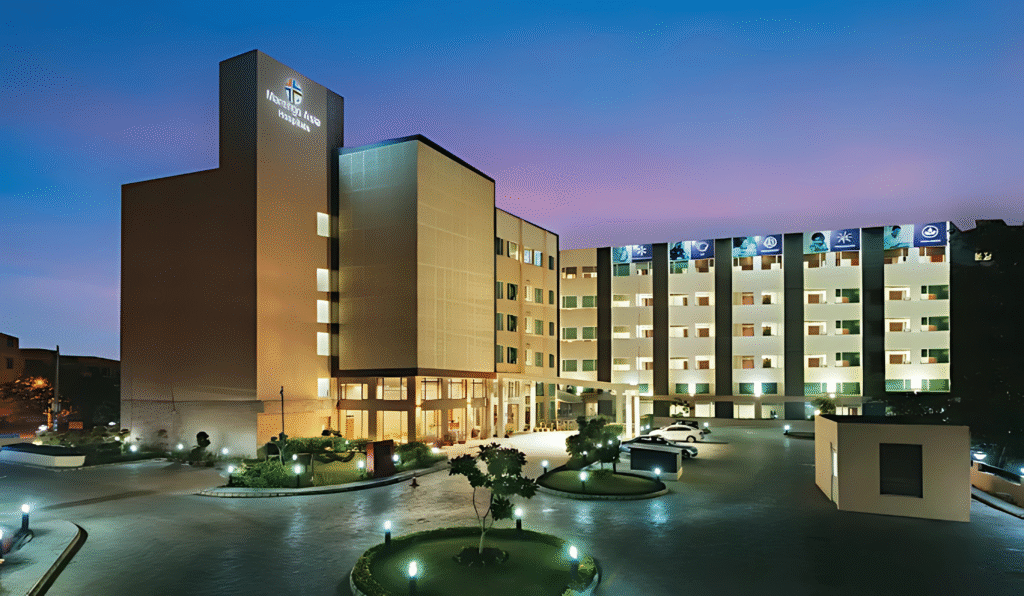Urinary Incontinence Treatment Cost in India

What is Urinary Incontinence?
Urinary incontinence is the involuntary leakage of urine, meaning a person urinates when they don’t want to. It occurs when control over the urinary sphincter is weakened or lost. This condition is more common in older adults, especially women, but it can affect people of all ages.
There are different types of urinary incontinence, each with specific causes and symptoms. It can be a temporary issue caused by a urinary tract infection or a chronic condition due to underlying health problems. Though it’s not life-threatening, it can significantly impact a person’s quality of life, confidence, and daily activities.
How Does Urinary Incontinence Develop?
Urinary incontinence develops when the muscles and nerves that help the bladder hold or release urine become weak or damaged. This can happen due to a variety of reasons such as aging, childbirth, surgeries, neurological disorders, or chronic conditions like diabetes.
In a healthy urinary system, the bladder stores urine until it’s convenient to release it. The brain signals the bladder muscles to tighten and the sphincter to relax when it’s time to urinate. If this system is disrupted due to injury, disease, or muscle weakness, it can lead to unintentional urine leakage.
Causes and Risk Factors of Urinary Incontinence
Urinary incontinence can result from a range of temporary or chronic causes. Understanding these helps in proper diagnosis and treatment.
1. Weakened Pelvic Floor Muscles:
Especially common in women after childbirth or menopause, weakened muscles can’t hold urine effectively.
2. Pregnancy and Childbirth:
Hormonal changes and the pressure of the fetus can weaken bladder control, and vaginal delivery can damage the pelvic floor.
3. Prostate Issues (in Men):
Enlarged prostate or prostate surgery can interfere with normal bladder function.
4. Urinary Tract Infections (UTIs):
Infections irritate the bladder, leading to a strong urge to urinate and, sometimes, leakage.
5. Neurological Disorders:
Conditions like Parkinson’s disease, stroke, multiple sclerosis, or spinal injuries disrupt nerve signals between the brain and bladder.
6. Aging:
With age, bladder muscles may lose strength, reducing the amount of urine the bladder can hold.
7. Obesity:
Extra weight increases pressure on the bladder, weakening the muscles over time.
8. Medications and Alcohol:
Certain medications or substances can interfere with bladder control.
Symptoms of Urinary Incontinence
The symptoms can vary based on the type and severity of incontinence, but commonly include:
1. Involuntary Leakage of Urine:
Leaking urine while sneezing, coughing, laughing, or lifting something heavy.
2. Urge to Urinate Frequently:
An intense and sudden urge to urinate followed by involuntary leakage.
3. Nocturia:
Waking up multiple times at night to urinate.
4. Incomplete Emptying:
Feeling like your bladder isn’t completely empty after urinating.
5. Bedwetting:
Common in children but can occur in adults due to specific conditions.
6. Continuous Dribbling:
Steady leakage of urine, especially in overflow incontinence.
Types of Urinary Incontinence
Urinary incontinence is classified into several types based on its cause and symptoms. Each type requires a specific treatment approach:
Occurs when physical movement or activity — such as coughing, sneezing, running, or heavy lifting — puts pressure (stress) on your bladder, causing leakage. It’s common in women post-childbirth or after menopause.
Also known as overactive bladder (OAB), this is characterized by a sudden, intense urge to urinate followed by involuntary leakage. It may be caused by infections, or more serious conditions like neurological disorders or diabetes.
Happens when the bladder doesn’t empty completely, leading to overflow and unexpected leakage. It’s more common in men with prostate issues or people with diabetes or nerve damage.
This occurs when a person recognizes the need to urinate but cannot reach the bathroom in time due to physical or mental limitations like arthritis or dementia.
A combination of stress and urge incontinence, often seen in elderly individuals or women post-menopause.
Which Type of Urinary Incontinence is the Most Dangerous?
Among these, urge incontinence and overflow incontinence can be considered more serious, particularly when they result from underlying conditions such as:
1. Neurological Disorders:
Urge incontinence may signal conditions like multiple sclerosis or Parkinson’s disease, which require medical intervention.
2. Chronic Urinary Retention:
Overflow incontinence can lead to increased bladder pressure, causing damage to the kidneys if left untreated.
Therefore, these types not only impact quality of life but also pose risks to long-term health if not properly managed.
Why Choose India for Treatment of Urinary Incontinence
India has rapidly become a leading destination for international patients seeking effective and affordable treatment for urinary incontinence. Here are the key reasons why:
India boasts a vast pool of highly experienced and internationally trained urologists, urogynecologists, and pelvic floor therapists. These specialists are skilled in diagnosing all types of urinary incontinence and creating personalized treatment plans using global best practices.
Top-tier hospitals in India are equipped with the latest diagnostic tools such as urodynamic testing systems, 3D/4D ultrasound machines, and advanced MRI scanners. For treatment, they offer minimally invasive surgery, robotic-assisted procedures, and laser therapies—all at par with Western standards.
Treatment for urinary incontinence in India is significantly more affordable than in countries like the USA, UK, or Australia. Despite the lower cost, patients receive world-class care, modern facilities, and international-standard hygiene and safety protocols.
Indian healthcare providers offer integrated treatment that addresses not only the physical symptoms but also the emotional and lifestyle factors. Many hospitals have dedicated continence care units that combine medical, physical therapy, psychological, and dietary guidance.
India has a well-developed medical tourism ecosystem. From airport pickups and visa assistance to language translators and concierge support, hospitals make the journey easy for international patients. Many also provide virtual consultations and follow-ups post-treatment.
Unlike many countries with long waiting lists, India ensures quick access to specialists and treatment procedures. This leads to faster diagnosis, reduced discomfort, and improved recovery time for the patient.
India’s excellence in urology and women’s health has been endorsed by patients from across the world. Cities like Delhi, Mumbai, Chennai, and Bengaluru house NABH and JCI-accredited hospitals that cater specifically to the needs of global patients.
Different types of Urinary Incontinence Treatment in India
Urinary incontinence can be managed effectively using a range of treatment options depending on the type, severity, and underlying cause of the condition. These treatments can be non-invasive, minimally invasive, or surgical. Treatment plans are often tailored to the individual’s needs, lifestyle, and overall health. Here are the most common and effective treatments used:
How it works:
Medications like anticholinergics, mirabegron, alpha-blockers, and topical estrogen help relax the bladder muscles, increase bladder capacity, or improve urethral sphincter strength.
When it’s used:
Used in urge incontinence, overflow incontinence, and mixed types—especially when lifestyle or behavioral changes alone are not sufficient.
Benefits:
Reduces urgency, frequency, and leakage episodes without requiring surgical intervention.
Recovery:
No recovery time needed. Patients may experience mild side effects like dry mouth or constipation.
How it works:
Surgical interventions aim to support or reposition the bladder and urethra, or control the urinary sphincter function.
When it’s used:
Recommended when conservative treatments fail or when incontinence is caused by anatomical issues or severe pelvic floor weakness.
Benefits:
Long-term relief from stress or urge incontinence, particularly effective for patients with severe symptoms.
Recovery:
Recovery can take 2–6 weeks depending on the type of surgery and the patient’s condition.
How it works:
This behavioral therapy involves gradually increasing the time between urinations to train the bladder to hold urine longer.
When it’s used:
Typically used in urge and mixed incontinence. Best for patients with cognitive ability and motivation to follow the routine.
Benefits:
Non-invasive, no medication required, improves bladder control over time.
Recovery:
No physical recovery needed, but full results may take several weeks of consistent effort.
How it works:
Involves exercises like Kegels and biofeedback techniques to strengthen pelvic floor muscles and improve urinary control.
When it’s used:
Commonly used for stress, urge, and mixed incontinence in both men and women.
Benefits:
Non-invasive, improves pelvic support, enhances muscle tone, and may prevent the need for surgery.
Recovery:
Gradual progress with no downtime; noticeable improvement usually within weeks.
How it works:
Electrical impulses are delivered to nerves controlling bladder function to restore normal communication between the bladder and brain.
When it’s used:
Recommended for patients with severe urge incontinence, especially when medications don’t work.
Benefits:
Minimally invasive, can significantly reduce urgency and frequency, and improve bladder control.
Recovery:
Recovery is usually minimal; patients may resume normal activities within a few days.
Cost of Different Procedures for Urinary Incontinence Treatment in India
Some patients may require advanced procedures, particularly when other methods have failed or when structural issues are involved. Below are the leading procedures performed for urinary incontinence:
How it works:
Partial or complete removal of the bladder, often followed by bladder reconstruction or a urostomy.
When it’s used:
Typically for severe incontinence due to bladder cancer or irreversible bladder dysfunction.
Benefits:
Eliminates problematic bladder and restores urinary function via alternative pathways.
Recovery:
Longer recovery of 4–6 weeks; involves post-op rehabilitation and lifestyle adjustments.
How it works:
A surgical mesh or tissue sling is placed around the urethra to support it and prevent leakage.
When it’s used:
Most commonly used in stress urinary incontinence, especially in women.
Benefits:
Highly effective, minimally invasive, and long-term relief.
Recovery:
Patients usually resume normal activities within 1–2 weeks.
How it works:
Botulinum toxin is injected into the bladder muscle to relax it and reduce overactivity.
When it’s used:
Used in urge incontinence when medications don’t work.
Benefits:
Minimally invasive, provides relief for 6–12 months per session.
Recovery:
Minimal recovery; slight burning sensation during urination for a day or two post-injection.
How it works:
An implantable device mimics the function of the natural urinary sphincter, allowing patients to control urination.
When it’s used:
Primarily in men with incontinence after prostate surgery.
Benefits:
Provides reliable continence and enhances quality of life.
Recovery:
Surgical recovery takes 2–3 weeks; device activation occurs after healing.
How it works:
A small device implanted near the sacral nerves delivers electrical impulses to regulate bladder activity.
When it’s used:
Effective in treating urge incontinence and overactive bladder not responsive to other treatments.
Benefits:
Minimally invasive, improves bladder control significantly.
Recovery:
Short recovery time; patients typically resume normal activities in a few days.
How it works:
Bulking agents are injected around the urethra to improve its closure and prevent leakage.
When it’s used:
Used for mild stress incontinence, especially in women not fit for surgery.
Benefits:
Quick outpatient procedure, low risk, and improves continence.
Recovery:
Minimal downtime, patients return to normal life almost immediately.
This procedure removes lymph nodes near the prostate to check if cancer has spread beyond the gland. It is usually done during radical prostatectomy or as a separate procedure.
Benefits:
✔ Helps determine cancer stage
✔ Reduces the risk of cancer spreading
When It’s Used:
✔ High-risk prostate cancer cases
✔ When lymph node involvement is suspected
Cost of Urinary Incontinence Treatment in India
India is known for offering world-class medical care at a fraction of the cost compared to Western countries. The cost of treating urinary incontinence varies widely based on the type of treatment or procedure chosen, the hospital, city, and the patient’s individual condition. Here’s a general overview:
| Treatment/Procedure | Estimated Cost (INR) | Estimated Cost (USD) |
|---|---|---|
| Medications (monthly) | ₹2,000 – ₹6,000 | $25 – $75 |
| Pelvic Floor Therapy (per session) | ₹1,000 – ₹2,500 | $12 – $30 |
| Bladder Training (with consultation) | ₹1,500 – ₹3,500 | $18 – $42 |
| Neuromodulation (Implant + Procedure) | ₹2,00,000 – ₹4,00,000 | $2,400 – $4,800 |
| Bladder Botox (per session) | ₹50,000 – ₹1,00,000 | $600 – $1,200 |
| Sling Procedure | ₹75,000 – ₹1,50,000 | $900 – $1,800 |
| Artificial Urinary Sphincter | ₹3,00,000 – ₹5,00,000 | $3,600 – $6,000 |
| Sacral Nerve Stimulation | ₹2,50,000 – ₹4,50,000 | $3,000 – $5,400 |
| Urethral Bulking (per session) | ₹40,000 – ₹80,000 | $480 – $960 |
| Cystectomy (Partial/Complete) | ₹2,50,000 – ₹6,00,000 | $3,000 – $7,200 |
Note: These are approximate figures. Final costs may vary based on diagnostic tests, hospital charges, surgeon fees, stay duration, and post-op care.
Why It’s Cost-Effective in India
Affordable yet high-quality care with internationally trained urologists and advanced technologies.
Significant savings even when including travel, stay, and recovery expenses.
Medical visa assistance and concierge services for international patients.
Best Doctors for Urinary Incontinence Treatment in India
Best Hospitals for Urinary Incontinence Treatment in India
Med Travel India Offerings
How does Med Travel India help you?
Services offered by Med Travel India

Seamless Planning for Your Medical Journey
Before you even arrive, we take care of all the groundwork. From connecting you with top specialists to ensuring all necessary medical evaluations are completed, we make your journey stress-free. Our goal is to provide clarity and comfort before your treatment begins.
- Free Medical Consultation
- Personalized Treatment Plan
- Estimated Cost & Duration
- Visa Assistanc
- Second Opinion Service
- Pre-Arrival Coordination
Worry-Free Travel & Comfortable Stay
We ensure that your journey to India is as smooth as possible. From booking your flights to arranging a comfortable stay near your hospital, we handle everything so you can focus on your health.
- Flight Booking Assistance
- Accommodation Booking
- Airport Pickup & Drop
- Language Interpretation Services
- Local Transport Arrangements
- Currency Exchange Support


World-Class Medical Care, Personalized for You
We ensure that your medical treatment is well-organized and efficient. Our team works closely with hospitals to facilitate smooth admissions, consultations, and procedures, ensuring you receive top-quality healthcare.
- Priority Appointment Scheduling
- Direct Hospital Admission
- Specialist Doctor Assignment
- Pharmacy & Medical Supplies
- Hospital Admission & Discharge Support
- 24/7 Customer Assistance
Continued Support for a Speedy Recovery
Your health journey doesn’t end after treatment. We provide post-procedure assistance to ensure a smooth recovery, whether you stay in India for rehabilitation or return home.
- Post-Surgical Care Coordination
- Rehabilitation & Physiotherapy
- Virtual Doctor Consultations
- Diet & Lifestyle Guidance
- Extended Stay Arrangements
- Post-treatment Medical Supplies


Beyond Healthcare, A Comfortable Experience
We offer additional services to make your stay in India comfortable and enriching, ensuring that your well-being is cared for beyond the hospital.
- Medical Insurance Settlement Help
- SIm Card Assistance
- Customized Sightseeing Tours
- Medical Document Assistance
- Personalized Assistance for Family Members
- Concierge Services







































